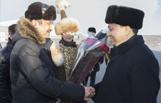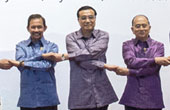Issue of comfort women enters most urgent moments
(jschina.com.cn) Updated: 2014-11-26 14:17The first "comfort women" museum in Japan has been largely ignored by the Japanese media. Ms Ikeda Eriko, curator of the museum, stated: "The issue (of comfort women) has entered its most urgent moments."
In recent years, the most disturbing voices denying military comfort women were largely from Tokyo. Yet it was in this same city that the Women's Active Museum on War and Peace (known as WAM for short) was erected with the aim of collecting and displaying evidence of sexual violence against women by the Japanese military during the Second World War.
Comfort Women Issue — Battles between Two Courts
WAM developed from the battle between the Japanese High Court and civil organizations that supported female war-time victims in suing the Japanese government.
The Japanese High Court, which lies to the west of Tokyo Imperial Palace, is a rather angular building. On March 2, 2010, within its walls a final judgment was made about the Chinese comfort women lawsuit that ascertained that eight women had been kidnapped and raped by members of the Japanese military but rejected the demands of the plaintiffs for compensation. Regarding the 10-plus lawsuits from China and South Korea on forced comfort women by Japanese soldiers, the verdict from the Japanese High Court was a defeat for these female victims.
There is, however, another courthouse in Tokyo that seeks justice for these war-ravaged females — The Women's International War Crimes Tribunal on Japan's Military Sexual Slavery. In the heart of Waseda City lies a small white building. Its second floor is home to WAM. Journalists have seen photos and video footage shown at the hearings of the tribunal at the museum in which, in the year 2000, a group of 64 victims from eight countries including the Chinese sex slave Wan Ai'hua are seen appearing at the court and relating their tragic experience of forced sex by Japanese soldiers. The tribunal declared Japanese Emperor Hirohito, Itagake Seishiro and Umezu Yoshijiro guilty and urged the Japanese government to apologize and pay compensation to the victims.
Ms Ikeda Eriko, the curator of WAM, said this civil court was organized by Ms Matsui Yayori, the founder of WAM. Ms Matui was a reporter at Asashi Shimbun News and the museum was established according to her will. She felt that because China and Korea had set up museums for the comfort women, Japan, as the instigating country, should also have a similar data library. In her last two months before cancer took her life away, Ms Matui did all she could to collect material and data and donated all her assets to the organization.
"This is all historical evidence the Japanese government keeps from the public"

This 10 square meter data house has on its entrance walls photos of comfort women. At the bottom or sides of each photo are the names and countries of origin of every victim.
"She was the first person to reveal the Japanese savagery against women." "This is the last Korean victim that can testify in Japan." "This is the first Chinese woman to publicly accuse Japan of barbarous treatment of women, Wan Ai'hua." Ms Ikeda attentively introduced the pictures which total 155, just the tip of the iceberg when you consider the fact that thousands of unidentified women went through hell. The Japanese military expropriated civilian households and forced local women to be comfort women, which was "blatant rape".
However hard the military and government of Japan try to block its people from knowing, there is solid evidence in the museum, ranging from audio records to written testimonies, of the foul treatment of these brave women. And some Southeast Asian women, although illiterate, illustrated their horrible experiences in the form of picture-stories.
Ms Ikeda stated that many Japanese veterans distorted the facts by saying these women volunteered to serve them. "The soldiers took by force women in Southeast Asia. This was a war crime and that is why the whole military kept it secret from the top to the bottom," she said.
There has been frequent attacks by rightwing deviationists since the opening of the museum, with the largest being a protest by 40 people. They say the museum commemorates prostitutes and that Ms Ikeda is a traitor and anti-Japan. Although in her 60s and somewhat fragile, Ms Ikeba is fighting vigorously to maintain WAM's normal operations. The museum is located in an expensive part of Tokyo. Its total income, from tickets, donations and book sales, amounted to 16.22 million yen, while its costs are 21.9 million yen. The deficit can only be closed using Ms Umezu's inheritance.










